I confess. ‘Live’ is a bit of an exaggeration. In truth, I was in Phnom Penh twice during a two-week trip to Cambodia. The second time I stayed at the Anik Palace Hotel, no 14, Street 278.
A good city should be well-planned, with a degree of rationality and logic. A city also needs romance.
I applaud the notion that engineers should build roads. I object if those same engineers are also responsible for naming streets. The name ‘Street 278’ lacks any sense of intrigue, beauty, history, or romance. It certainly doesn’t capture the bubbling people-centered small-scale vitality of Phnom Penh. I think that poets should take charge of naming streets. Of course, poets should have a strictly curtailed role in city planning and building: a poet has no affinity for a well-designed sewage system.
I had the pleasure of reading the recent ‘Where I Live…..’ blogs penned by my good friend and esteemed colleague Tommie Thompson (Singapore, Bangkok, and Manila) so I thought, even if formed by only the cursory perspective of a short-haul tourist, a ‘Phnom Penh blog’ would make a nice companion piece. I felt a slight competitive instinct as well – what could be called the ‘Battle of the Pearls’. Tommie noted that Manila was once nicknamed the ‘Pearl of the Orient’ and Bangkok the ‘Venice of the East’. My enthusiastic guidebook proclaimed that Phnom Penh was likewise once dubbed ‘the Pearl of Asia’. Is this a slightly shop-worn comparison cut and pasted by the national tourist authorities of each country from some inspired (and forgotten) original poetic source? Is it wistful colonial nostalgia emanating from the West? Either way, I do wonder when European cities will be first labeled as ‘the Beijing of the West’ or the ‘Calcutta of Europe’. When this happens, it will say a lot about global politics. Read all the blogs and decide for yourself, which is the most Pearl-y city lived in by one of the CCI-team.
I was a resident on an upper story and took a photograph from a hotel window. Anik Palace Hotel is located in Sangkat Boeung Keng Kang I, a rapidly developing central area of Phnom Penh. The image captures the density of the city center. We can also see the mix of lower-level, older, red-roof buildings and the more modern, recently constructed high-rise buildings. Phnom Penh is turning from a pancake into a pyramid, to use the memorable terminology from a recent World Bank study of urbanization. A pancake design is where the city spreads horizontally at low levels of density and a pyramid design where the city grows by building upwards, or vertical layering.
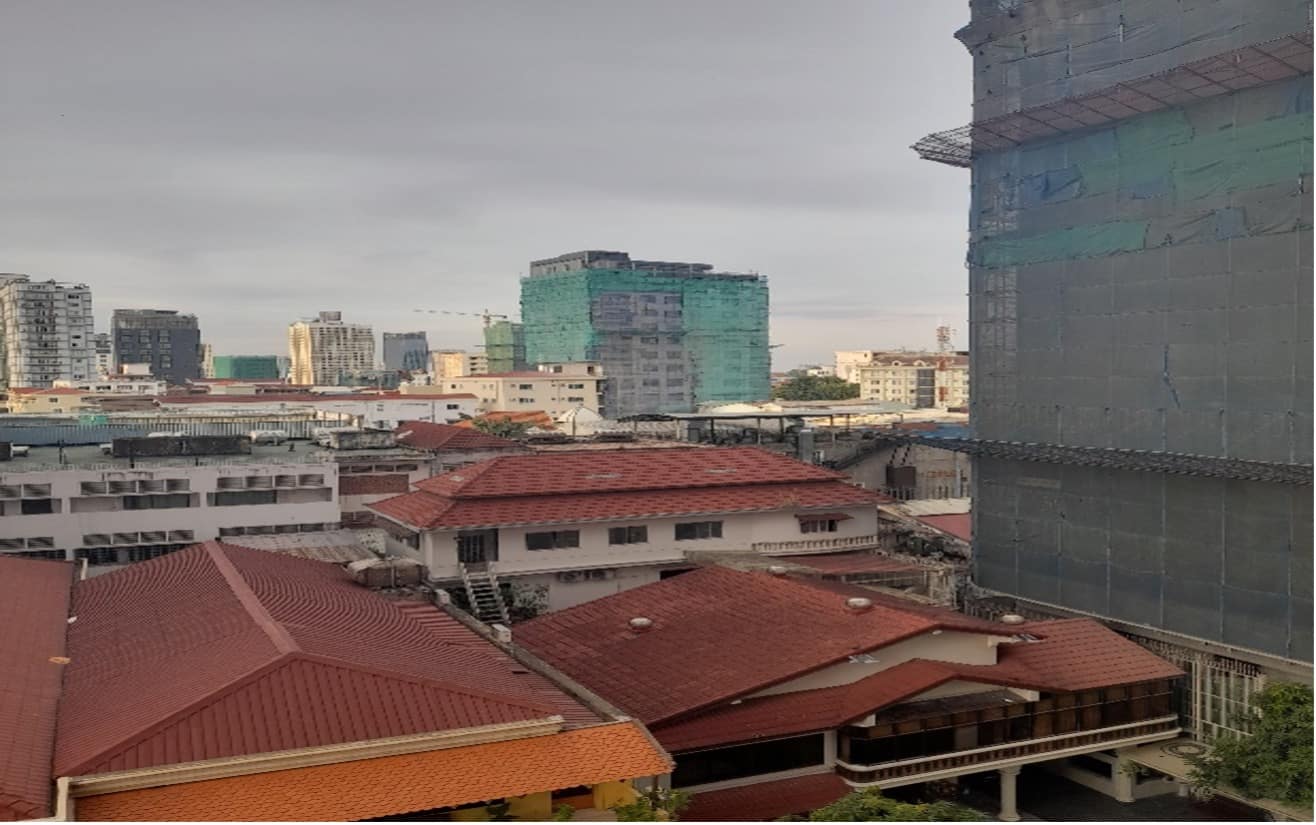
As per my long-established two-city blog tradition, I exited the hotel and turned right.
Phnom Penh is a delightful combination of the big city vibe and the informal, small-scale market bustle, with skyscrapers and big department stores looming over neighborhood cafes, vegetable stalls, and shops. I found all the daily amenities and more occasional pleasures needed for city life during my thirty-minute walk. As Tommie noted in the case of Bangkok, Phnom Penh is also a 15-minute city. I walked past an eclectic mix of small eateries (restaurants is too grand a term) – Japanese, Thai, Vietnamese, and Khmer (local) – and market stalls selling fresh seafood, meat, piles of bright fruit and vegetables. There were countless opportunities for great coffee. Sometimes it was a smart purpose build, trendy coffee shop. Sometimes it was an entrepreneur towing a stall and several plastic chairs behind a Honda Dream II motorbike. Every encounter with coffee was mediated through the sparkling charms of a gleaming high-tech Italian coffee machine.
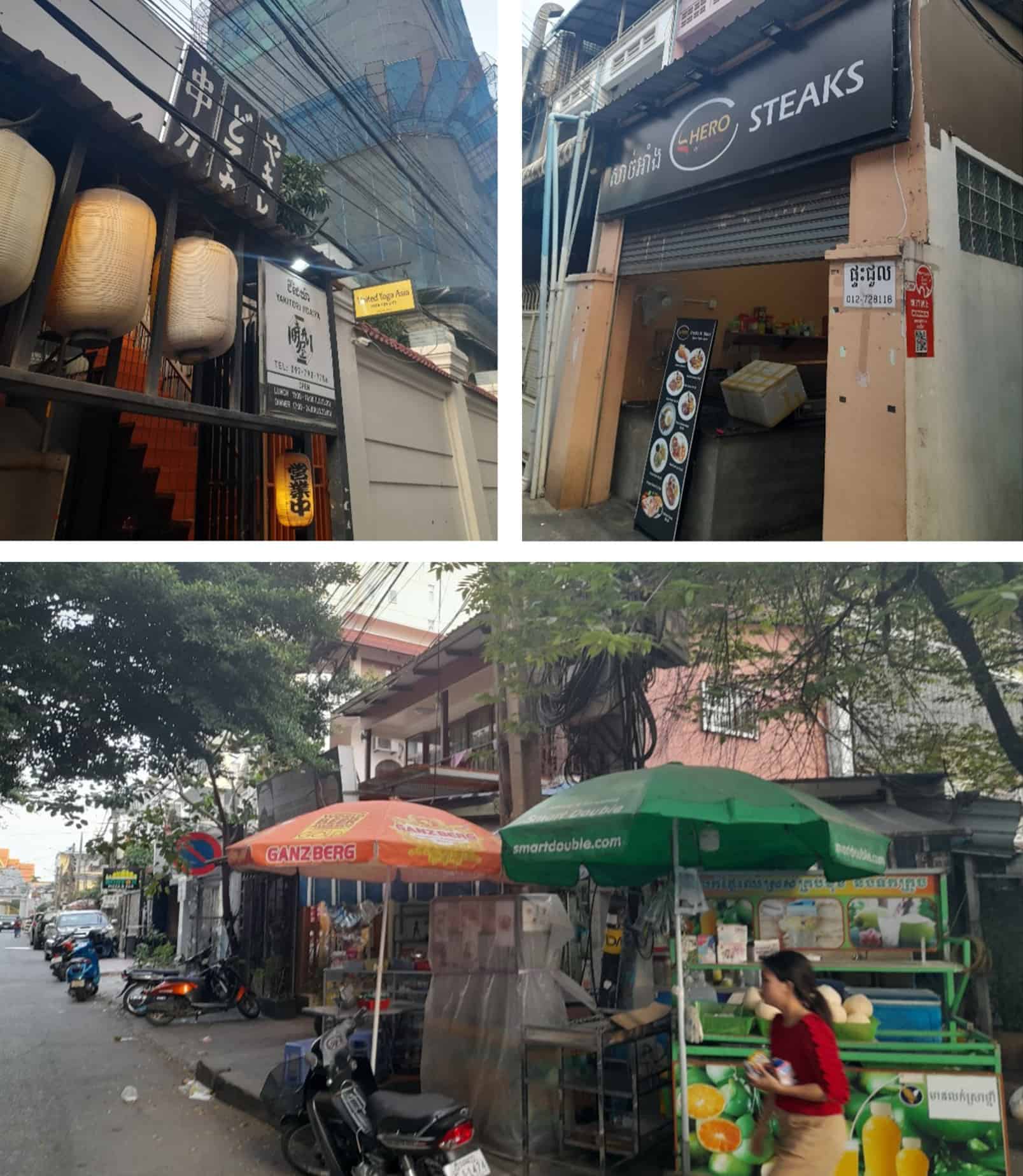
What I glimpsed from above, I now saw from the street level. My neighborhood stroll took me past a nice mix of the older, more traditional, low-rise buildings and the newly built towers. A happy balance or an impending victim of remorseless developmental energy? With only a cursory impression and absent detailed research, I can’t tell whether this happily livable mix of the large-modern and small-traditional is going to be a permanent fixture of Phnom Penh. Will ‘development’ continue and the city be relentlessly transformed into somewhere like Beijing, where wide sidewalks stretch for long-distances, past smoked glass-fronted malls which reflect back the glaring sun? Will Phnom Penh retain those piles of cooling fruit and inviting two-table bars, more like modern Tokyo? I guess it will ultimately depend on the politics of planning, real estate developers, city government officials, and preservation priorities.
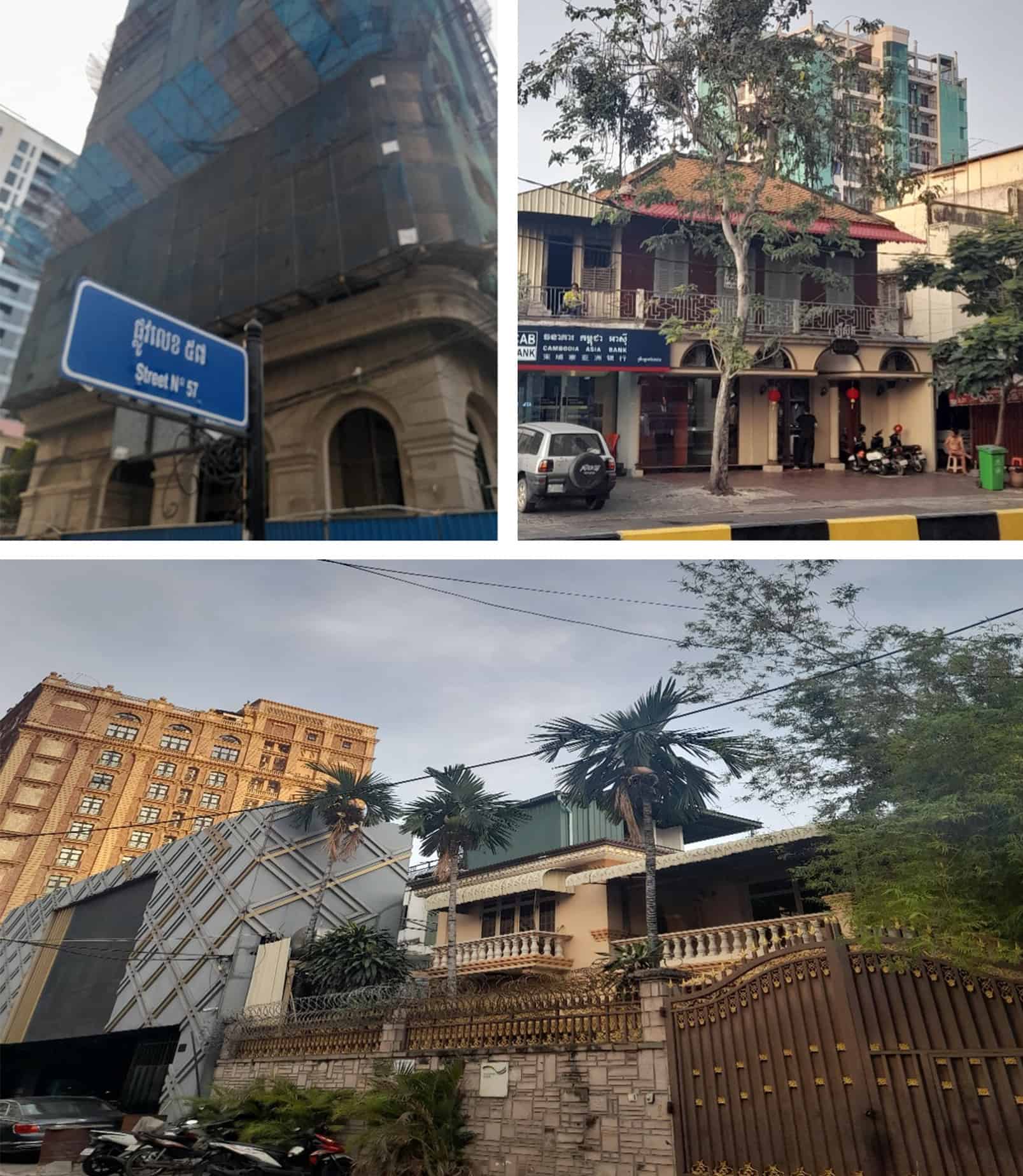
Much of the walk was tiring and stressful. Often, the pavements (sidewalks for my American readers) were crumbling, non-existent, or crowded with urban commercial vitality. The narrow streets were filled with an incredible variety of transport jostling for space among themselves, in near ignorance of any unexpected walkers. Transport unfamiliar to most of the developed world included the ubiquitous motorized Tuk-Tuk and even cycle rickshaws. I passed a garage filled with the most magnificent array of concentrated driving opulence I have ever seen: a Lamborghini, a Bentley, a Rolls Royce. A gentleman of a slightly menacing appearance stood in the entrance in a muscled black ambience. I took a quick photo when he looked in the opposite direction.
Even though so much is accessible within a short distance, this is a city which demands a purposeful mission (by foot or local transport) to find fresh vegetables or a bowl of steaming noodles; it isn’t a city to go for a meandering walk.

There is startling grassroots private-sector energy in Phnom Penh, particularly in commerce and transport. Much of the infrastructure provision has been effectively privatized. With only one exception, every café or bar I visited in Cambodia offered their own free Wi-Fi. Air-conditioning units hugged every building exterior. I spotted one motorcycle converted into a private recycling operation. Motorcycles were everywhere and their ownership cascades down the income spectrum in Cambodia; this is one reason why road building has a significant impact on accessibility and poverty reduction in Cambodia and Southeast Asia more generally, but not Africa.
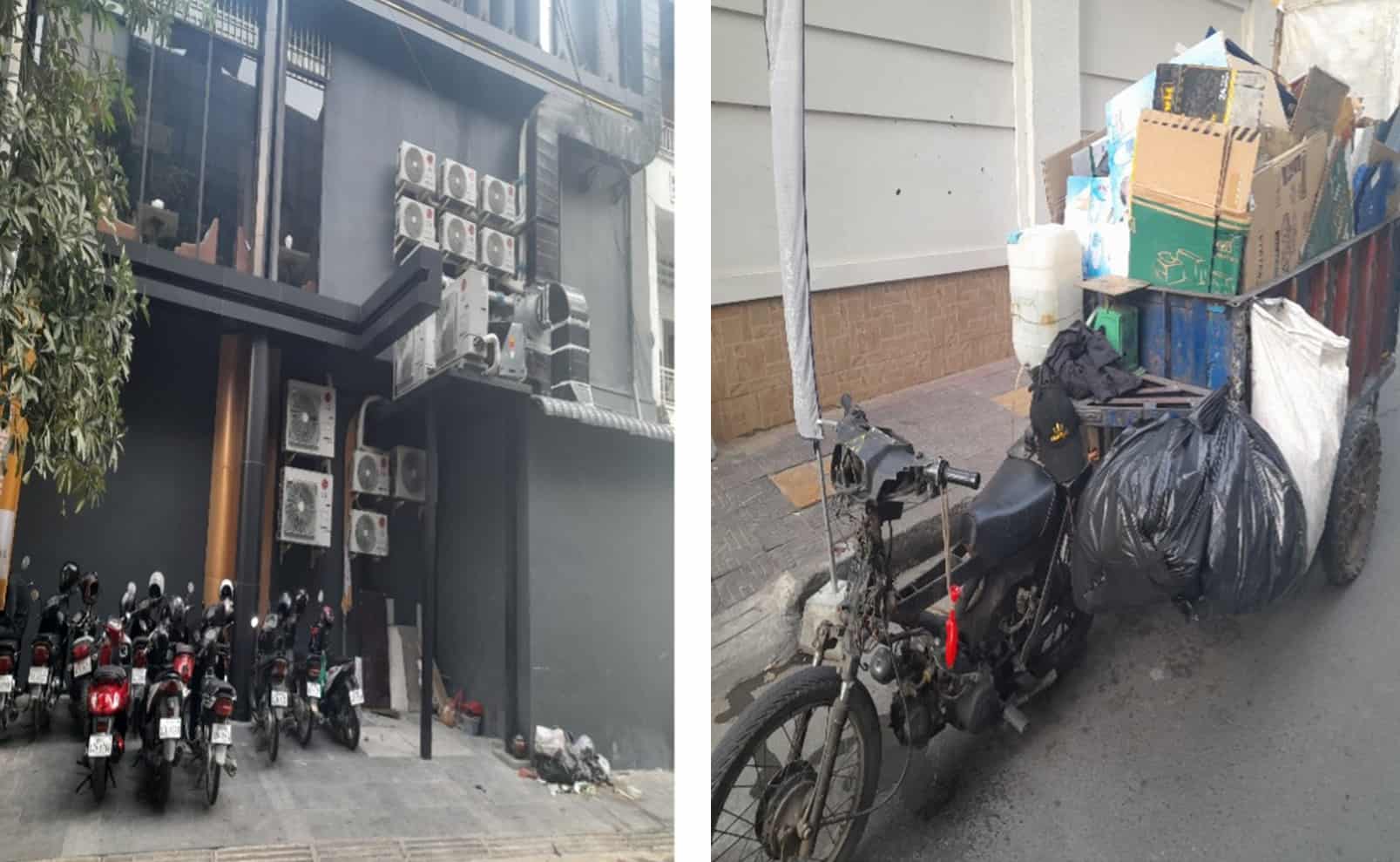
The rapid expansion of Phnom Penh and associated energy of the private sector has left the government sector trailing in its wake. Government infrastructure is creaking under rising demand, often spilling out awkwardly and forming additional obstacles for this intrepid walker to negotiate. The electricity system was designed for a less demanding, low-rise city and is now struggling to keep pace with the intensification of urbanization. According to the World Bank 2020 Doing Business Report, Cambodia ranked 146th of 190 countries for ‘Getting Access to Electricity’. There were four procedures involved which took an average of 179 days and cost 1,700% of income per capita. It seems plausible that people are attaching home-made cables to the electricity system, a kind of informal privatization of government infrastructure?
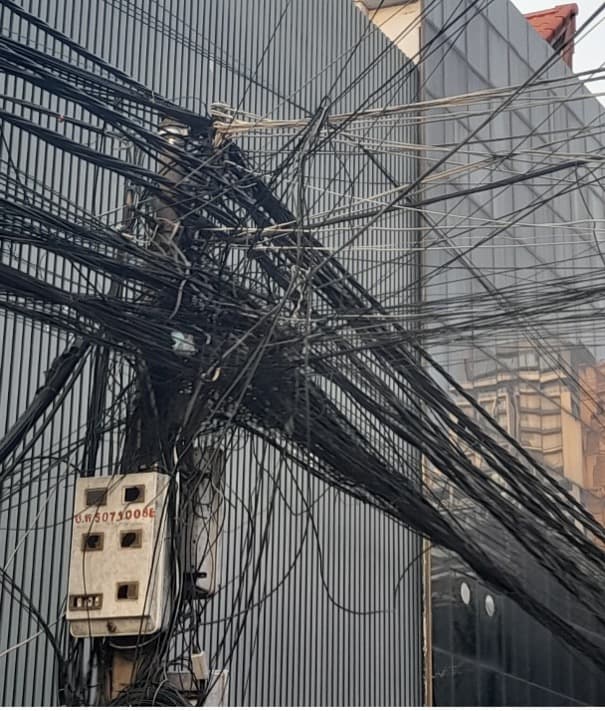
I finished my thirty-minute squashed-circle walk and returned to the Anik Palace slightly frazzled but with a long list of potential dining options for that evening.
How do I reflect on Phnom Penh in the context of Charter Cities Institute and our love of all things urban?
Within my lifetime, Cambodia was subject to one of the most grotesque horrors of the twentieth century. In the early 1970s, Cambodia was buffeted by the complexities of post-colonial nation-building, US bombing of supply lines during the American War in Vietnam, and a long-standing conflict with much larger neighbor Vietnam. Taking advantage of this chaos, on the 17th of April 1975, the Khmer Rouge (Cambodian nationalist-communists) entered Phnom Penh and deposed the existing government. Three days later, the Khmer Rouge unleashed an ideology of startling puritanical horror and ordered the evacuation of all urban areas. Where CCI advocate establishing good institutions to give individuals and firms an incentive to invest, the Khmer Rouge abolished private property. Where CCI advocate promoting trade and foreign investment, the Khmer abolished money and markets and sought to build a totally self-sufficient economy. Where CCI advocate the benefits of urbanization, the Khmer Rouge abolished urbanization and sought to build an agrarian paradise. Where CCI learns from history – such as the urbanization experiences of Hong Kong, Shenzhen, and Dubai – the Khmer Rouge sought to purge society of the educated to start history again at ‘Year Zero’. Where CCI aspires to lift tens of millions out of poverty, the Khmer Rouge murdered 3 million from the original population of 8 million. It was an appalling way to reflect on what constitutes a good development strategy.
I also saw the resilience of cities. As an organizational form, cities can be bombed in war, destroyed in earthquakes, or, as in Cambodia, completely abolished. Nonetheless, cities bounce back with incredible vitality. Although CCI advocates for the building of new cities, CCI can and should also think about helping to re-build cities broken by tragedy. In 1975, Phnom Penh was abolished. In 2023, the Phnom Penh I saw was buzzing, lively, and demonstrative of good, accessible urbanization. In 2021, only 5% of the population of Cambodia were aged 65 years+. This was the population that would remember the genocide. Cambodia is a young country with 31% of the population aged 14 or under. This is the young population about to inherit the opportunities of employment, recreation, dynamism, and the wonky pavements of Phnom Penh.







